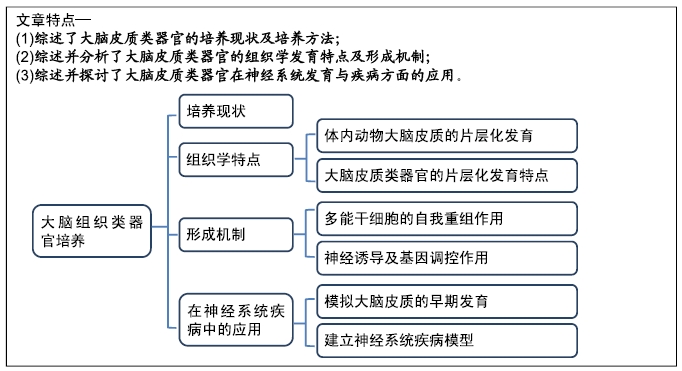[1] CLEVERS H. Modeling Development and Disease with Organoids. Cell. 2016;165(7):1586-1597.
[2] LANCASTER MA, RENNER M, MARTIN CA, et al. Cerebral organoids model human brain development and microcephaly. Nature. 2013;501 (7467):373-379.
[3] EIRAKU M, WATANABE K, MATSUO-TAKASAKI M, et al. Self-organized formation of polarized cortical tissues from ESCs and its active manipulation by extrinsic signals. Cell Stem Cell. 2008;3(5): 519-532.
[4] EIRAKU M, TAKATA N, ISHIBASHI H, et al. Self-organizing optic-cup morphogenesis in three-dimensional culture. Nature. 2011;472(7341): 51-56.
[5] CHEUNG C, BERNARDO AS, PEDERSEN RA, et al. Directed differentiation of embryonic origin-specific vascular smooth muscle subtypes from human pluripotent stem cells. Nat Protoc. 2014;9(4): 929-938.
[6] TAKEBE T, SEKINE K, ENOMURA M, et al. Vascularized and functional human liver from an iPSC-derived organ bud transplant. Nature. 2013;499(7459):481-484.
[7] TAKASATO M, ER PX, CHIU HS, et al. Kidney organoids from human iPS cells contain multiple lineages and model human nephrogenesis. Nature. 2015;526(7574):564-568.
[8] RAY K. Development: Modelling human stomach development with gastric organoids. Nat Rev Gastroenterol Hepatol. 2017;14(2):68.
[9] FORSTER R, CHIBA K, SCHAEFFER L, et al. Human intestinal tissue with adult stem cell properties derived from pluripotent stem cells. Stem Cell Reports. 2014;2(6):838-852.
[10] THOMSON JA, ITSKOVITZ-ELDOR J, SHAPIRO SS, et al. Embryonic stem cell lines derived from human blastocysts. Science. 1998; 282 (5391):1145-1147.
[11] TAKAHASHI K, TANABE K, OHNUKI M, et al. Induction of pluripotent stem cells from adult human fibroblasts by defined factors. Cell. 2007; 131(5):861-872.
[12] TAKAHASHI K, YAMANAKA S. Induction of pluripotent stem cells from mouse embryonic and adult fibroblast cultures by defined factors. Cell. 2006;126(4):663-676.
[13] 范文娟,王倩,孙仪征,等.起源于小鼠诱导性多能干细胞的大脑皮质类器官的建立及其生物学特性[J].解剖学报,2017,48(4): 387-396.
[14] BERSHTEYN M, KRIEGSTEIN AR. Cerebral organoids in a dish: progress and prospects. Cell. 2013;155(1):19-20.
[15] MOU H, VINARSKY V, TATA PR, et al. Dual SMAD Signaling Inhibition Enables Long-Term Expansion of Diverse Epithelial Basal Cells. Cell Stem Cell. 2016;19(2):217-231.
[16] ANTONICA F, KASPRZYK DF, SCHIAVO AA, et al. Generation of Functional Thyroid Tissue Using 3D-Based Culture of Embryonic Stem Cells. Methods Mol Biol. 2017;1597:85-95.
[17] LEE J, SUGIYAMA T, LIU Y, et al. Expansion and conversion of human pancreatic ductal cells into insulin-secreting endocrine cells. Elife. 2013;2:e00940.
[18] CHOI J, IICH E, LEE JH. Organogenesis of adult lung in a dish: Differentiation, disease and therapy. Dev Biol. 2016;420(2):278-286.
[19] VASIOUKHIN V, BAUER C, YIN M, et al. Directed actin polymerization is the driving force for epithelial cell-cell adhesion. Cell. 2000;100(2): 209-219.
[20] ADAMS CL, CHEN YT, SMITH SJ, et al. Mechanisms of epithelial cell-cell adhesion and cell compaction revealed by high-resolution tracking of E-cadherin-green fluorescent protein. J Cell Biol. 1998; 142(4):1105-1119.
[21] BENTON G, ARNAOUTOVA I, GEORGE J, et al. Matrigel: from discovery and ECM mimicry to assays and models for cancer research. Adv Drug Deliv Rev. 2014;79-80:3-18.
[22] TANIGUCHI K, SHAO Y, TOWNSHEND RF, et al. Lumen Formation Is an Intrinsic Property of Isolated Human Pluripotent Stem Cells. Stem Cell Reports. 2015;5(6):954-962.
[23] 刘厚奇,蔡文琴. 医学发育生物学[M].北京:科学出版社, 2012:177-199.
[24] MCMAHON JA, TAKADA S, ZIMMERMAN LB, et al. Noggin-mediated antagonism of BMP signaling is required for growth and patterning of the neural tube and somite. Genes Dev. 1998;12(10):1438-1452.
[25] BIER E, DE ROBERTIS EM, EMBRYO DEVELOPMENT. BMP gradients: A paradigm for morphogen-mediated developmental patterning. Science. 2015;348(6242):aaa5838.
[26] CHAE WJ, EHRLICH AK, CHAN PY, et al. The Wnt Antagonist Dickkopf-1 Promotes Pathological Type 2 Cell-Mediated Inflammation. Immunity. 2016;44(2):246-258.
[27] GUO Y, XIE J, RUBIN E, et al. Frzb, a secreted Wnt antagonist, decreases growth and invasiveness of fibrosarcoma cells associated with inhibition of Met signaling. Cancer Res. 2008;68(9):3350-3360.
[28] WANG JY, DEL VALLE L, GORDON J, et al. Activation of the IGF-IR system contributes to malignant growth of human and mouse medulloblastomas. Oncogene. 2001;20(29):3857-3868.
[29] APPEL B, EISEN JS. Retinoids run rampant: multiple roles during spinal cord and motor neuron development. Neuron. 2003;40(3):461-464.
[30] MASON JO, PRICE DJ. Building brains in a dish: Prospects for growing cerebral organoids from stem cells. Neuroscience. 2016;334: 105-118.
[31] KELAVA I, LANCASTER MA. Stem Cell Models of Human Brain Development. Cell Stem Cell. 2016;18(6):736-748.
[32] LANCASTER MA, CORSINI NS, WOLFINGER S, et al. Guided self-organization and cortical plate formation in human brain organoids. Nat Biotechnol. 2017;35(7):659-666.
[33] MATSUI A, JARVIE BC, ROBINSON BG, et al. Separate GABA afferents to dopamine neurons mediate acute action of opioids, development of tolerance, and expression of withdrawal. Neuron. 2014;82(6):1346-1356.
[34] BAGLEY JA, REUMANN D, BIAN S, et al. Fused cerebral organoids model interactions between brain regions. Nat Methods. 2017;14(7): 743-751.
[35] DOUDNA JA, CHARPENTIER E. Genome editing. The new frontier of genome engineering with CRISPR-Cas9. Science. 2014;346(6213): 1258096.
[36] ISSA L, KRAEMER N, RICKERT CH, et al. CDK5RAP2 expression during murine and human brain development correlates with pathology in primary autosomal recessive microcephaly. Cereb Cortex. 2013; 23(9):2245-2260.
[37] GARCEZ PP, LOIOLA EC, MADEIRO DA COSTA R, et al. Zika virus impairs growth in human neurospheres and brain organoids. Science. 2016;352(6287):816-818.
[38] DANG J, TIWARI SK, LICHINCHI G, et al. Zika Virus Depletes Neural Progenitors in Human Cerebral Organoids through Activation of the Innate Immune Receptor TLR3. Cell Stem Cell. 2016;19(2):258-265.
[39] GABRIEL E, RAMANI A, KAROW U, et al. Recent Zika Virus Isolates Induce Premature Differentiation of Neural Progenitors in Human Brain Organoids. Cell Stem Cell. 2017;20(3):397-406.
[40] MARIANI J, COPPOLA G, ZHANG P, et al. FOXG1-Dependent Dysregulation of GABA/Glutamate Neuron Differentiation in Autism Spectrum Disorders. Cell. 2015;162(2):375-390.
[41] CHANG KH, LEE-CHEN GJ, HUANG CC, et al. Modeling Alzheimer's Disease by Induced Pluripotent Stem Cells Carrying APP D678H Mutation. Mol Neurobiol. 2019;56(6):3972-3983.
[42] LOPES FM, BRISTOT IJ, DA MOTTA LL, et al. Mimicking Parkinson's Disease in a Dish: Merits and Pitfalls of the Most Commonly used Dopaminergic In Vitro Models. Neuromolecular Med. 2017;19(2-3): 241-255.
[43] ROBBINS JP, PRICE J. Human induced pluripotent stem cells as a research tool in Alzheimer's disease. Psychol Med. 2017;47(15): 2587-2592.
[44] LANCASTER MA, KNOBLICH JA. Generation of cerebral organoids from human pluripotent stem cells. Nat Protoc. 2014;9(10):2329-2340.
[45] GIANDOMENICO SL, LANCASTER MA. Probing human brain evolution and development in organoids. Curr Opin Cell Biol. 2017;44:36-43.
|


